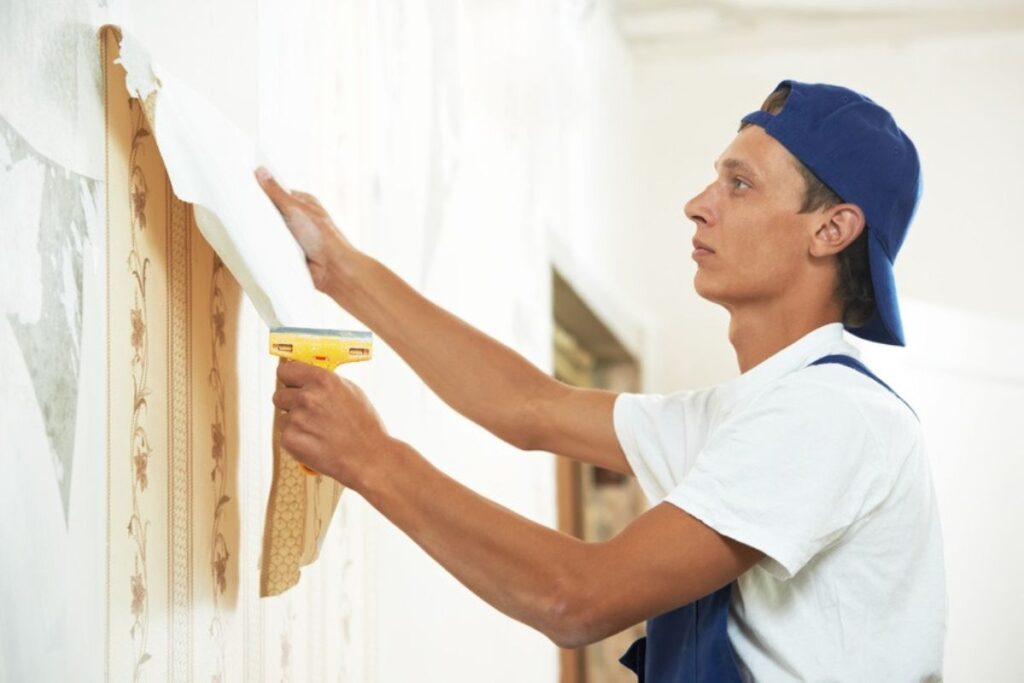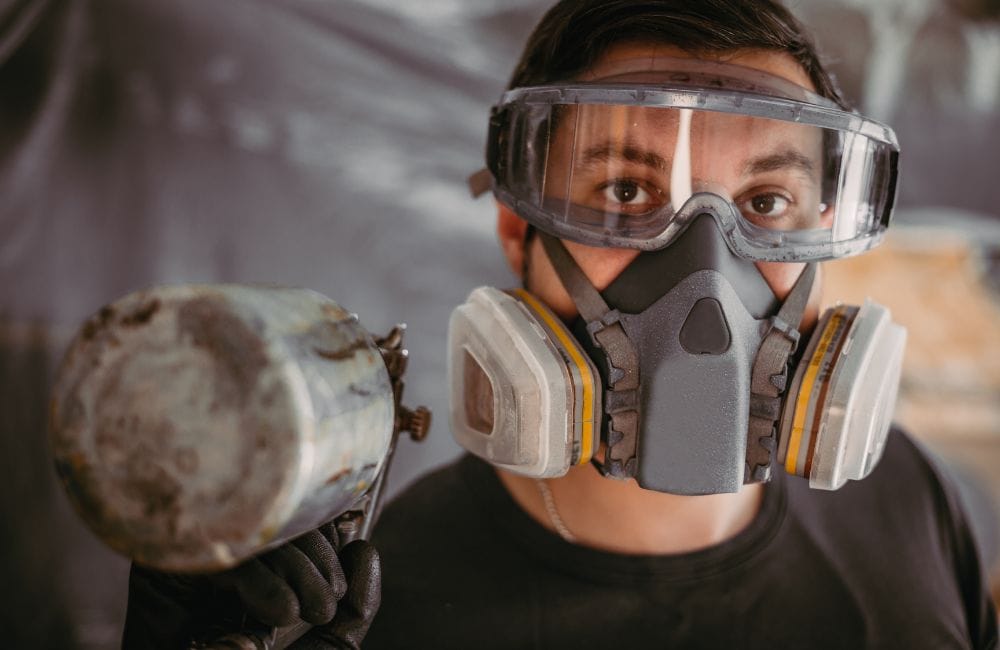Menu

Key Takeaways✔ Identify the wallpaper material to choose the safest and most effective removal method. ✔ Gently peel a corner to see how easily it detaches and adjust the approach as needed. ✔ Apply a proven wallpaper removal solution to break down adhesive without harming the wall. ✔ Lightly score the surface to help the solution penetrate stubborn wallpaper layers. ✔ Allow enough soaking time so the adhesive loosens fully for smoother removal. ✔ Use a plastic scraper to lift wallpaper without damaging the drywall underneath. ✔ Wash off leftover glue, check for damage, and prepare the surface for its next finish |
Wallpaper remains a popular design choice in homes and commercial spaces across the U.S., with the market expected to reach over $700.5 million by 2030. As more people embrace wallpaper for its style and personality, the need for safe and efficient removal methods also grows—especially when preparing for a new look or preserving wall quality.
Here are essential wallpaper removal solution secrets that save time and prevent wall damage
Understanding what kind of wallpaper is on the wall is the first step in any safe and efficient removal process. Different wallpaper materials react differently to moisture, heat, and tools.
Each wallpaper type needs its own removal strategy. Knowing what you’re dealing with saves time and prevents wall damage.
Knowing the wallpaper’s material helps in choosing between scraping vs. steaming wallpaper and whether to try DIY methods or call in a pro.
Understanding how well the wallpaper sticks to the wall is the first step in planning an efficient and safe removal process. This quick check helps determine the condition of the wall underneath and which wallpaper removal solution or method will be most effective.
Before applying any solution, it’s important to test a small area. This reveals how the wallpaper is attached and whether it will come off easily or need more effort.
Testing adhesion can prevent unnecessary damage and guide the right choice between scraping vs. steaming wallpaper.
Once adhesion is tested, the proper course of action can be chosen with confidence.
Choosing the correct wallpaper removal solution is one of the most important steps in avoiding wall damage and saving time. Whether opting for a commercial product or a DIY mix, the goal is to loosen the adhesive safely and effectively.
Before beginning, it’s helpful to understand the different types of solutions available. The wrong choice can make the job harder and even risk damage to the drywall.
Scoring is a critical step in effective wallpaper removal. It helps the wallpaper removal solution soak through the surface and reach the adhesive underneath. Without proper scoring, the solution may not penetrate fully, making the removal much harder and increasing the risk of wall damage.
Wallpaper, especially vinyl-coated or washable types, often repels moisture. This makes it difficult for any solution to seep through unless the surface is broken.
Not all wallpapers need to be scored. Before using a tool, test a corner or edge of the wallpaper.
Using the right method and tool can prevent accidental wall damage.
Scoring should be strategic, not aggressive. Over-scoring can cause more harm than good.
Applying a wallpaper removal solution is only half the job—letting it soak properly is what actually softens the adhesive and makes the removal process easier and safer. Skipping or rushing this step often leads to extra scraping, wall damage, and frustration.
Giving the wallpaper removal solution enough time to work helps avoid unnecessary scraping and keeps the wall surface intact. Letting it sit allows it to fully break down the glue beneath the wallpaper.
Keeping the wall moist for the right duration can be a challenge, especially with thicker or vinyl-coated wallpaper.
How long to let the solution soak depends on the type of wallpaper and adhesive used.
Removing wallpaper can be delicate work, especially when trying to protect the wall underneath. The right tools and techniques are critical to avoid unnecessary damage.
Not all tools are created equal when it comes to wallpaper removal. A plastic putty knife is often the safest and most effective choice.
Some areas may resist even the best tools and solutions. In these cases, technique matters just as much as the tool itself.
After the wallpaper has been removed, it’s essential to properly clean and prepare the walls. This ensures a smooth, damage-free surface that’s ready for painting or a fresh layer of wallpaper.
Even after the wallpaper is gone, adhesive residue can linger on the wall. Using the right approach will protect the surface and avoid future issues with finishes.
Once the adhesive is cleaned off, it’s time to assess the wall’s condition. This is an important step whether the wallpaper was removed using scraping vs. steaming wallpaper methods.
Proper prep helps paint or new wallpaper stick better and last longer. Whether it’s a DIY wallpaper removal tip or part of a professional wallpaper removal service, prepping is a must.

While many wallpaper projects can be tackled independently, certain situations call for expert support. In these cases, a professional wallpaper removal service in West Hartford, CT, can prevent costly damage and ensure the job is done efficiently using safe wallpaper removal techniques.
Walls with several layers of wallpaper can be difficult to penetrate and remove cleanly. Professionals have tools and experience to handle these complex removals without harming the surface underneath.
Some types of wallpaper, like vinyl-backed or commercial-grade materials, are designed to last—and so is their glue. Removing these without the right equipment can damage the wall, making expert help a smart choice.
When drywall begins to peel or crumble, it’s best to stop and consult a specialist. A trained team can safely continue the process and repair any issues without making things worse.
Effective wallpaper removal often requires scoring tools, steamers, or specialized wallpaper removal solutions. Hiring a pro saves time and ensures the process stays on track with minimal disruption.
While it is possible to paint over wallpaper, it’s generally not recommended. The paint may not adhere properly, and seams or textures can show through the finished surface. If the wallpaper is in excellent condition and well-adhered, you might get away with it after priming. However, for best results, removing the wallpaper is always the better option.
The time it takes to remove wallpaper varies based on room size, type of wallpaper, and method used. On average, it can take a few hours to an entire day for a standard room. More stubborn or layered wallpapers can take longer. Proper preparation and tools can significantly speed up the process.
Most traditional wallpaper is not designed to be reused once removed. The adhesive backing typically gets damaged or loses its stickiness during the removal process. Even peel-and-stick wallpaper can stretch or tear, making it difficult to reapply smoothly. If reusability is a concern, it’s best to use removable wallpaper that’s specifically labeled as reusable.
A hair dryer may work in small areas by heating the adhesive, but it’s not as effective as a steamer. It doesn’t produce enough consistent heat or moisture to loosen large sections of glue. This method can be helpful for stubborn corners or edges. For full rooms, a wallpaper steamer is more practical and efficient.
You can often feel leftover adhesive as a sticky or rough residue on the wall. Sometimes it appears shiny or slightly darker than the rest of the surface. Wiping the wall with a damp sponge can help reveal sticky areas. It’s important to remove all adhesive before painting or refinishing.
Tackle stubborn wallpaper and adhesive the right way with help from West Hartford House Painting Experts, the trusted name for interior surface prep in West Hartford, CT. Using proven methods and a careful approach, our local team ensures clean walls and smooth surfaces ready for paint or new wallpaper.
Call West Hartford House Painting Experts today to schedule your wallpaper removal service!

Welcome to West Hartford House Painting Experts. We believe that we are the highest quality painting company in this community and we provide excellent customer service!